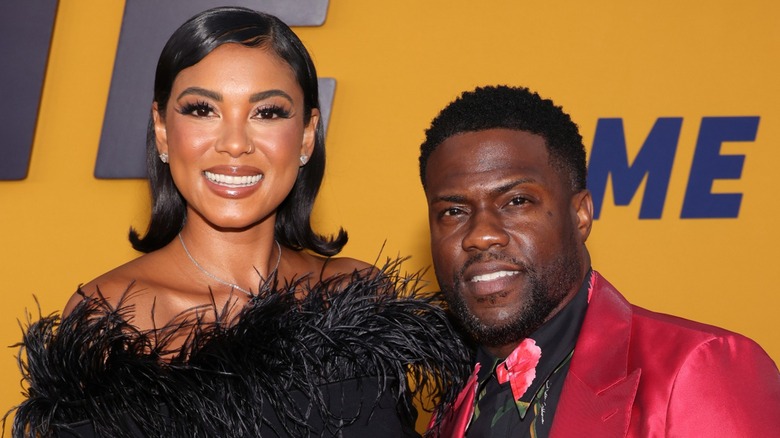Why Has Height Become Such A Significant Factor In Dating?
Everyone has preferences when it comes to romantic and sexual attraction. And while we'd all like to claim that we only care about what's on the inside, many of us gravitate towards partners with certain physical traits. The relationship between societal beauty standards and individual behavior is endlessly unpackable, but there's one particularly challenging beauty standard that casts a shadow over the dating world: height.
Shorter men might be having their moment in the sun as short king spring is officially here, but the dating odds aren't in their favor. According to a study in the "Journal of Family Issues," nearly 50% of women surveyed said they wanted to date men who were taller than them.
If you spend any time on a dating app, none of this is new information. Look at people's profiles and you'll quickly notice the fixation on height, whether it's men asserting that they're over six feet tall or women explicitly saying that they only date tall people. It's easy to take this dynamic for granted, but it's quite striking to see that at a time when more and more young adults espouse the virtues of body positivity, folks are still being brutally honest about which bodies they consider romantically and sexually viable.
Breaking down the height bias in dating
So how bad is the height bias in dating? To put it simply, very bad. Various studies examining women's height requirements for romantic partners indicate that preferences lean quite tall. A study published in "Personality and Individual Differences" concluded that most women want a partner who is 21 centimeters taller than them, which is a little over eight inches. To put that into context, the average height of a woman in the United States is around 5 feet, 4 inches, while the average height for men is 5 feet, 9 inches (per CDC). Based on those numbers, a man needs to be six feet tall — three inches taller than average — to have a better chance of dating the average woman.
The height bias becomes even more pronounced on dating apps. Going back to the earlier days of online dating, a 2005 study published by the University of Chicago showed that men who said they were 6 feet, 3 inches got 60% more messages than their 5 feet, 7-inch tall counterparts. More recently, the dating app MillionaireMatch shared that men who were six feet tall had the highest success rate for matches (per Business Wire).
This is all to say that the social stigma against short men (and tall women) is not just anecdotal. Where that stigma comes from, and whether it's time to finally ditch it, gets a little more complicated.
Where does our attraction to height come from?
When people describe what they're physically attracted to in a mate, they tend to have a "just because" attitude: water is wet, the sky is blue, and we like what we like. But we don't live in a vacuum, and there are biological and social factors that shape our perspective on height.
One potential culprit is genetics. Research indicates that the genes that control one's height might influence the height that you find attractive, with people being drawn to those that shared similar height traits on a genetic level (via Genome Biology). Aside from underlying genetic similarities, it's also theorized that we subconsciously look for survival advantages in potential partners, which could explain an innate attraction to tall, strong male partners, per Psychology Today.
However, the media we consume makes a connection between masculinity and height that is far more explicit than any subconscious biological instincts. For example, Girl Power Girl Strong's survey of romance novels found that the average height for male characters in the genre was 6 feet, 3 inches. You see the emphasis on height reinforced on the screen, as well, with scenes staged so that male leads appear taller than female co-stars (via NPR). While the height fixation could come from a natural place, our collective imagination around romance is certainly tipping the scales further in the favor of tall folks, and when put into a broader social context, this bias becomes deeply hurtful.
Dating app distortions
If it feels like height has become a much bigger issue in dating than it once was, you're not entirely wrong. Height has been a concern long before dating went digital, but dating apps have made it much easier for us to fixate on it. On an app, you're searching and filtering for matches in a way that's not dissimilar to online shopping. Qualities like height that wouldn't necessarily be realistic deal-breakers in person suddenly become a convenient way to narrow down your options.
Furthermore, dating apps exacerbate these superficial tendencies through collaborative filtering, an algorithm method that gives users suggestions based on the preferences of other similar users (via Harvard Data Science Review). Aside from the harmful racial bias this can produce, collaborative filtering also promotes a group-think mentality that can foreclose a user's chance to try something different. In the case of height, if an app determines that most men of average or short height don't like dating tall women, it might be more challenging for a taller woman to show up as a suggested match for men who are shorter than them. And, perhaps even more prevalent on dating apps, the algorithm may also assume that few women are interested in dating shorter men, and skew recommended matches to men with taller heights. Ultimately, this style of filtering limits a single person's opportunities for dating outside their type and reinforces existing cultural biases around height.
The height of success
The interest in tall partners and the cultural biases that come with it are about more than just looks. As problematic or superficial as it might be to take height into consideration for dating, it could still be seen as a potential shortcut for filtering out matches and finding a successful partner. A taller person can sometimes have better odds for financial security and professional advancement than a shorter person. A study from the University of Chicago found that people who were taller than average (regardless of gender) tended to make more money and were more likely to have a white-collar job than shorter people. This theory also has some merit when looking at the heights of U.S. presidents: we haven't had a president that was under 5 feet, 9 inches tall since 1901.
Even more powerful than the genuine correlation between height and success is the perceived connection between the two. Regardless of taller individuals' actual qualities, they are more likely to be viewed by others as confident and intelligent (per PLoS One). It's possible that when we see that someone says they're over 6 feet tall on their dating profile, our brains translate that to mean smart and successful.
The messy gender dynamics
Analyzing dating apps and our perceptions around height is relevant, but you can't talk about height preferences in dating without bringing up the gender problem. When you have an explicit requirement for a height difference between you and your partner that's based on gender, you're revealing a lot about how you view gender and sexuality, and how you expect others to conform to it.
For starters, the entire premise of a height minimum is grounded in heteronormativity. It assumes that your partner will be of the "opposite" gender and that you must each represent the most traditional and obvious features of a his-and-hers set. Although the height issue isn't entirely exclusive to heterosexual couples — the gay community also has a serious height complex, according to GQ — it is certainly a byproduct of outdated gender norms.
There is also a remarkably transphobic attitude that underlies any dating requirements related to height. If you narrow your dating pool to only partners that fulfill the "shorter woman/taller man" ideal, you'll end up excluding many trans folks. As transition coach James Barnes explains to Buzzfeed News in regards to trans men's dating experiences, "The women will say they're too short, straight-up say, 'I'm not even against you being trans, you're just not my type, I want a taller guy.'" A height preference can sound like a benign dating habit, but it can quickly become an implicit judgment on how someone else embodies their gender.
Is it attraction or objectification?
Beneath the height discourse lies a crucial question: are height preferences a matter of attraction, or are they just another way to objectify people? It's easy to get the two conflated, but attraction to physical traits and objectification are quite different, particularly in regard to how it impacts the subject of your gaze. Attraction stirs the natural chemistry between people — someone's beautiful hair or striking eye color. What starts as attraction can evolve into objectification when you take those qualities and make them an item that you can judge, possess, and project concepts onto.
A classic example is the size of a person's breasts. In isolation, finding large breasts attractive is perfectly fine, but when someone believes that having a partner with large breasts reflects positively on their own sexuality, or assumes that people with smaller breasts could never be as sexual as folks with large breasts, the attraction has become objectification. Perhaps the objectification of height doesn't cause the same level of harm as objectifying people's breasts, but the hurt still exists.
Suggesting that a person's stature (whether short or tall) makes them less sexually available, misaligned with their gender identity, or simply less likely to be a worthwhile person takes height preferences far beyond the realm of respectful attraction. While the dating world has made a lot of progress, it's clear that we still have a long way to go when it comes to even the most basic aspects of body acceptance.






